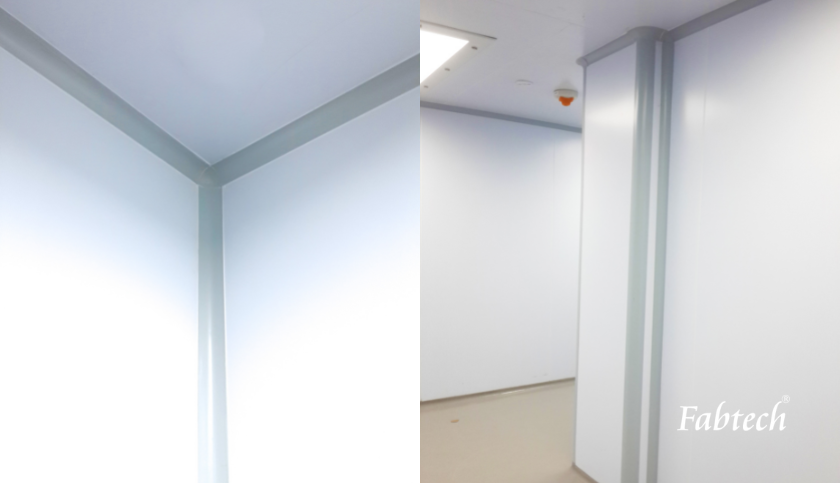Cleanroom Coving – holding that extra edge

A lot goes into maintaining a house with the latest facilities, especially in today’s fast-changing world, where even things like a false ceiling become a sign of luxury. Or is it simply about going with the times? No matter how much visual appeal they may promise, these suspended ceilings require an additional amount of cleanliness.
It is also true that false ceilings may not find a room for themselves everywhere by virtue of their high maintenance level. Therefore, for a place that calls for utmost cleanliness, it may not be ideal for making it compatible with false ceilings.
This room, in essence, has a self-explanation in its name. Cleanrooms, as we all know, are isolated, controlled environments that require an optimum standard to maintain a low concentration of airborne particles. However, cleanroom cleanliness may seem to be an endless process. For this reason, this engineered space encompasses stringent standard operating procedures (SOPs) and air-flow principles through HEPA filters, along with structural designs in the form of coving. Therefore, maintenance and hygiene in such a case go well beyond the routine cleaning regime and involve essentials to achieve a holistic particulate-free environment.
How does coving get you covered?
Unlike the conventional walls that stand at a 90-degree angle, coving along with coving corners give a well-rounded, seamless extension to a wall-to-ceiling and to a wall-to-wall, respectively. Simply put, coving installed at the edge of the walls give a smooth transition from a wall to the ceiling while corners help eliminate the sharp corners and enable a three-dimensional meeting points. In addition, covings are durable and non-shedding that not only hold up the weight but are also designed to withstand constant cleaning and sanitization processes required by the pharmaceutical and medical industries.
Pencil coving is another secure way of minimising the accumulation of water and minute dust. This cove comes at a modest size of 25mm (and goes up to 75mm) and is used as a joint between the wall and the floor. The installation of pencil coving greatly helps add convenience and ease to the regular cleaning practices.
As a result, regular cleaning on the part of the cleanroom operators gets simplified to a large extent so that there is a minimum accumulation of contaminants and a maximum cleanliness level can be maintained.
The Right Rounded Radius
Coving has found its place in several industries, viz. pharmaceutical factories, food and beverage processing, wet industrial environments, laboratories and sterile environment for the undermentioned attributes:
- As per the requirements of the current good manufacturing practices (cGMP), installing coving is a must to maintain sterile work.
- It prevents the entry of rodents and insects that may otherwise damage the structure.
- It provides a neat, clean and attractive finishing with an aesthetic appeal to the cleanroom, especially in wet and sanitised areas.
- It is easy to maintain and replace.
- It is the absolute answer to ‘attention to detail.’
- Installing coving is not an expensive affair.
- The benefits of coving outweigh its cost.
Why Aluminium Coving?
While there are various materials by which coving can be manufactured, viz. metal, aluminium, plaster or plastic, depending on specific institutional guidelines, each material is incorporated into the specific cleanroom environment and serves unique purposes.
Fabtech cleanrooms are well equipped with aluminium coving that fulfils diverse requirements.
- Eliminates dirt and bacteria that typically build up in any laboratory, processing room or cold room.
- Aluminium stands as a semi-structural function for added strength.
- An ideal choice for resistance owing to corrosion, aluminium also gives scope for additional finishes for extra robustness.
- It keeps the coving steady and rigid to carry the load.
- The L-shape profile firmly connects the walls and suspends them against the ceiling.
- Ideal for clean rooms having several columns and walls with alcoves and recesses.
- It has the superior ability to include silicone edges and facilitates an airtight seal.
- Unlike plastic coving with an inbuilt colour, aluminium coving can be used with powder coating that helps match the color of coving with that of the panel.
An insight into installation
The entire purpose of having a coving may get defeated if the same is not made to perfection. Below are a few vital points that must be borne in mind while installing coving in a cleanroom.
- Backing angles must be fixed into place with screws
- Corner coving should be put in place through clips.
- Coving should be sealed with silicone or sealant for a fully flush finish
- It must be made in a way that it works together with the flooring and the doors
- Coving must be made chemically resistant to withstand regular cleaning practices
- It should also be designed to be thermally resistant so as to leave room for possible fluctuations in temperature.
Fabtech cleanrooms – Not just ‘business as usual’
Fabtech takes pride in giving just the right quality of structural integrity to cleanrooms through coving. Our team of experts fabricate the aluminium coving with utmost precision and accuracy. The product is designed to act as a hygienic seal passage that can adjust seamlessly with the wall, ceiling and the floor.
Fabtech has grown to be one of the very established players in providing a range of supreme quality coving for your project. Our cleanrooms are performance indicators of our extensive know-how in the said domain. We won’t deny that we are emotionally invested in each project so that it takes us a step closer to our endeavour of saving millions of lives around the world.
Reach out to us to know more about our cleanroom flooring.
Categories
Recent Posts
Subscribe
Never miss a post from Fabtech. Sign up to receive updates direct to your inbox.
